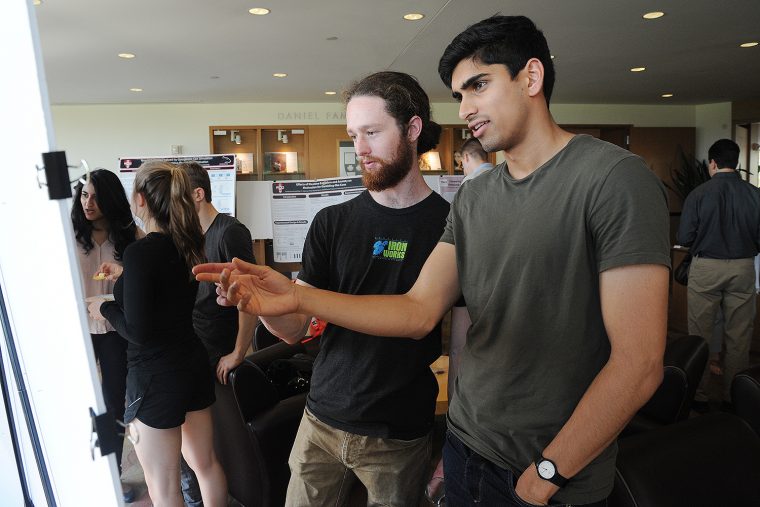Wesleyan faculty frequently publish articles based on their scholarship in The Conversation US, a nonprofit news organization with the tagline, “Academic rigor, journalistic flair.” In a new article, Mike Robinson, assistant professor of psychology, writes that brain science explains how gambling games hook players, including casual ones. Robinson also is assistant professor of neuroscience and behavior, assistant professor of integrative sciences. Designed to deceive: How gambling distorts reality and hooks your brain To call gambling a “game of chance” evokes fun, random luck, and a sense of collective engagement. These playful connotations may be part of why almost 80 percent of American…
Drug and behavioral addictions like gambling are characterized by an intense and focused pursuit of a single reward above other healthier endeavors. Pursuit of the addictive reward is often compulsively sought despite adverse consequences. In a newly published study, Mike Robinson, assistant professor of psychology, neuroscience and behavior, and integrative sciences explored how our decisions can become narrowly focused onto one particular choice. He and his research team used laser light (optogenetics) to activate the central portion of the brain's amygdala (CeA), an area normally known for its role in generating responses to drug-related and fearful stimuli. The study, titled "Optogenetic…
Wesleyan faculty frequently publish articles based on their scholarship in The Conversation US, a nonprofit news organization with the tagline, “Academic rigor, journalistic flair.” Janice Naegele, the Alan M. Dachs Professor of Science, writes about the implications of a controversial new neuroscience study from the University of California, San Francisco. Naegele also is professor of biology and professor of neuroscience and behavior. Read her bio on The Conversation. Scientists have known for about two decades that some neurons—the fundamental cells in the brain that transmit signals—are generated throughout life. But now a controversial new study from the University of California, San Francisco, casts doubt…
Psyche Loui, assistant professor of psychology, assistant professor of neuroscience and behavior, assistant professor of integrative sciences, co-authored a new article published in the December 2017 issue of Brain and Cognition. The paper is titled, "Jazz Musicians Reveal Role of Expectancy in Human Creativity." Loui and her colleagues found that within one second of hearing an unexpected chord, there is a world of differences in brain responses between classical and jazz musicians. (more…)
Writing in The Conversation, Assistant Professor of Psychology Mike Robinson looks to the brain to explain the real reason that some people become addicted to drugs. Robinson, who also is assistant professor of neuroscience and behavior, assistant professor of integrative sciences, begins by debunking two popular explanations for drug addiction: that compulsive drug use is simply a "bad habit," and that overcoming the unpleasant withdrawal symptoms is too hard for some addicts. While pleasure, habits and withdrawal can play a role in drug use, Robinson says, the true reason for addiction can be explained by the psychological differences between "wanting" and "liking." (more…)
Psyche Loui, assistant professor of psychology, assistant professor of neuroscience and behavior, assistant professor of integrative sciences, is the author of a new publication on musical anhedonia—the lack of pleasure from music. Together with others in her lab, Loui studied an individual with musical anhedonia and compared his brain against a group of controls. They found that his auditory cortex was differently connected to his reward system, a finding which gives further support for the role of brain connectivity in the musical experience. The article, titled, "White Matter Correlates of Musical Anhedonia: Implications for Evolution of Music," was published Sept.…
Hundreds of Wesleyan students had the opportunity to present their academic research at various poster sessions in March and April. Posters often contain text, graphics and images that illustrate the students' research results on a single board. Poster session attendees can view the posters and interact with the author. This year, the Psychology Department, College of the Environment, Biology Department, Neuroscience and Behavior Program, Natural Sciences and Mathematics Division, Quantitative Analysis Center and the Department of Earth and Environmental Sciences hosted poster sessions. Photos of the poster sessions are below: (Photos by Olivia Drake, Caroline Kravitz '19 and Rebecca Goldfarb Terry '19) (more…)
Assistant Professor of Psychology Psyche Loui and Rachel Guetta ’17 are the authors of a new paper exploring how people form associations between sound and taste. The article, titled, “When Music is Salty: The Crossmodal Associations Between Sound and Taste,” was published March 29 in the journal PLoS One. Scientists know that music can be evaluated as sweet, sour, salty or bitter, depending on features in its composition such as pitch, articulation, or brightness. For example, higher pitches are often thought of as sweet or sour, and lower pitches associated with bitterness. While previous research has studied this general area,…
In human beings, the cerebellum occupies only 10 percent of the brain volume, yet has approximately 69 billion neurons; that is 80 percent of the nerve cells in the brain. In the book Evolution of the Cerebellar Sense of Self, published by Oxford University Press in January, co-authors David Bodznick and John Montgomery use an evolutionary perspective to explain cerebellar research to a wide audience. Bodznick is professor of biology, professor of neuroscience and behavior at Wesleyan, and Montgomery is professor of biology and marine science at the University of Auckland in New Zealand. The cerebellum first arose in jawed…
In June, Jan Naegele, professor of biology, professor of neuroscience and behavior, traveled to Mundgod, India to teach Tibetan monks through the Emory-Tibet Science Initiative (ETSI), a program promoting "the convergence of science and spirituality as two complementary systems of knowledge," according to the Emory Tibetan Partnership. ETSI was founded as a pilot in 2006 by Emory University at the bequest of the 14th Dalai Lama. Naegele's journey, which she took together with her husband, Dr. Paul Lombroso, was described in the Winter 2016 issue of Rutland Magazine, in an article featuring many photographs provided by Naegele. (more…)
Charles Sanislow, associate professor of psychology, associate professor of neuroscience and behavior, is the author of two papers in leading journals for psychiatry and psychology on his work with the National Institute of Mental Health (NIMH) Research Domain Criteria (RDoC). The RDoC is a framework to drive translational research to improve psychiatric diagnosis and develop new and better treatments. In the October issue of World Psychiatry, Sanislow reports on ongoing RDoC work, including the consideration of adding the domain “Motor Systems” to the RDoC. Early this month, Sanislow participated in a workshop at NIMH to review the evidence for research…
Janice Naegele, professor of biology, professor of neuroscience and development, is the co-author of a new paper titled, "Convulsive seizures from experimental focal cortical dysplasia occur independently of cell misplacement." It was published in Nature Communications on June 1. Brain malformations called focal cortical dysplasia are typically formed during human embryonic cortical development and are a common cause of drug-resistant epilepsy and cognitive impairments. One of the causes of cortical dysplasia is improper migration of developing cortical neurons. Failure to reach their correct destinations in the cerebral cortex and dysregulated growth leads to the formation of growths or tubers in regions of…







